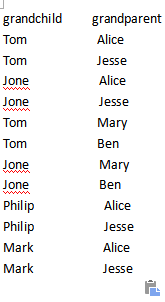"单表关联"要求从给出的数据中寻找所关心的数据,它是对原始数据所包含信息的挖掘。
实例描述 给出child-parent(孩子——父母)表,要求输出grandchild-grandparent(孙子——爷奶)表。
输入 输出:


问题分析:
这个实例需要进行单表连接,连接的是左表的parent列和右表的child列,且左表和右表是同一个表。连接结果中除去连接的两列就是所需要的结果——"grandchild--grandparent"表。要用MapReduce解决这个实例,首先应该考虑如何实现表的自连接;其次就是连接列的设置;最后是结果的整理 MapReduce的shuffle过程会将相同的key会连接在一起,所以可以将map结果的key设置成待连接的列,然后列中相同的值就自然会连接在一起了。
实现步骤:
1.map阶段将读入数据分割成child和parent之后,将parent设置成key,child设置成value进行输出,并作为左表;再将同一对child和parent中的child设置成key,parent设置成value进行输出,作为右表。
2.为了区分输出中的左右表,需要在输出的value中再加上左右表的信息,比如在value的String最开始处加上字符1表示左表,加上字符2表示右表。
3. reduce接收到连接的结果,其中每个key的value-list就包含了"grandchild--grandparent"关系。取出每个key的value-list进行解析,将左表中的child放入一个数组,右表中的parent放入一个数组,然后对两个数组求笛卡尔积就是最后的结果了。
代码:
import java.io.IOException;
import java.util.ArrayList;
import java.util.List;
import org.apache.hadoop.conf.Configuration;
import org.apache.hadoop.fs.FileSystem;
import org.apache.hadoop.fs.Path;
import org.apache.hadoop.io.Text;
import org.apache.hadoop.mapreduce.Job;
import org.apache.hadoop.mapreduce.Mapper;
import org.apache.hadoop.mapreduce.Reducer;
import org.apache.hadoop.mapreduce.lib.input.FileInputFormat;
import org.apache.hadoop.mapreduce.lib.output.FileOutputFormat;
public class connection {
static String INPUT_PATH = "hdfs://master:9000/qq";
static String OUTPUT_PATH="hdfs://master:9000/output";
static class MyMapper extends Mapper<Object,Object,Text,Text>{
Text output_key = new Text();
Text output_value = new Text();
protected void map(Object key,Object value,Context context) throws IOException,InterruptedException{
String[] tokens = value.toString().split(",");
output_key.set(tokens[0]);
output_value.set(2+","+value);
context.write(output_key, output_value);
output_key.set(tokens[1]);
output_value.set(1+","+value);
context.write(output_key,output_value);
}
}
static class MyReduce extends Reducer<Text,Text,Text,Text> {
Text output_key=new Text();
Text output_value=new Text();
protected void reduce(Text key, Iterable<Text> values,Context context) throws IOException,InterruptedException{
List<String> childs= new ArrayList<String>();
List<String> grands= new ArrayList<String>();
for(Text line:values){
String[] tokens=line.toString().split(",");
if(tokens[0].equals("1")){
childs.add(tokens[1]); //tom
//System.out.println(1+"=="+tokens[1]);
}
else if(tokens[0].equals("2")){
grands.add(tokens[2]);
// System.out.println(2+"=="+tokens[2]);
}
}
for(String c:childs)
for(String g:grands){
output_key.set(c);
output_value.set(g);
context.write(output_key, output_value);
}
}
}
public static void main(String[] args) throws Exception{
Path outputpath = new Path(OUTPUT_PATH);
Configuration conf = new Configuration();
FileSystem fs = outputpath.getFileSystem(conf);
if(fs.exists(outputpath)){
fs.delete(outputpath,true);
}
Job job=Job.getInstance(conf);
FileInputFormat.setInputPaths(job,INPUT_PATH);
FileOutputFormat.setOutputPath(job, outputpath);
job.setMapperClass(MyMapper.class);
job.setReducerClass(MyReduce.class);
// job.setMapOutputKeyClass(MyNewKey.class);
// job.setMapOutputValueClass(NullWritable.class);
job.setOutputKeyClass(Text.class);
job.setOutputValueClass(Text.class);
job.waitForCompletion(true);
}
}
最后就可以得出结论。